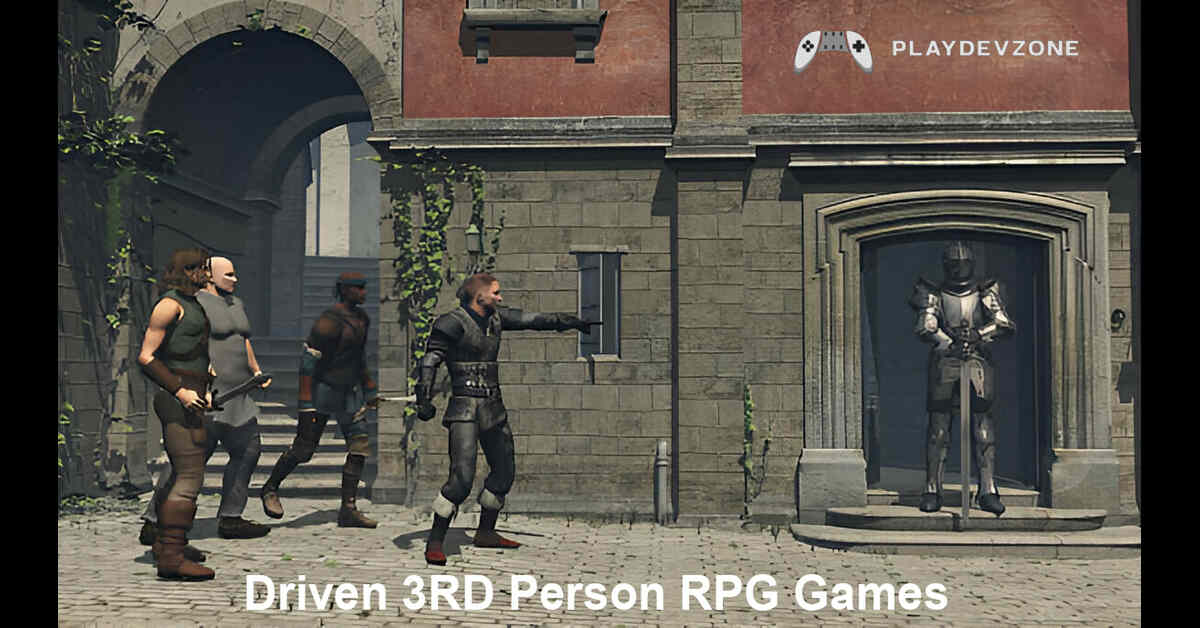Story-driven 3rd person RPG games have carved out a passionate and loyal fan base in the gaming world.
Known for their rich narratives, immersive character development, and cinematic gameplay, these titles appeal to more than just casual players.
But who exactly are the primary audiences behind this growing genre?
From hardcore gamers seeking emotional depth to newcomers drawn in by visually engaging storytelling, story-driven 3rd-person RPGs attract a diverse range of players.
In this post, we'll explore the key demographics, motivations, and interests of those who are captivated by these narrative-rich gaming experiences.
What Makes Story-Driven 3rd Person RPGs Unique?
Story-focused 3rd-person RPGs shine through their cinematic presentation, emotionally rich narratives, and compelling character arcs that pull players deep into the game world.
Unlike first-person or action-only games, these titles let players see their character evolve visually while emotionally engaging with the narrative.
The third-person perspective enhances world exploration, making the experience feel more dynamic and lifelike.
Player choices shape the experience whether through branching narratives, impactful moral decisions, or interactive dialogue options, every decision influences the path and outcome of the story.
From richly detailed environments to unforgettable companions, these games offer more than just action; they deliver an emotional, interactive experience.
That's why story-driven 3rd-person RPGs continue to attract gamers who crave depth, immersion, and meaningful gameplay.
What Drives Their Engagement?
What truly drives engagement in story-driven 3rd-person RPGs is the emotional connection players build with the characters and narrative.
Players are captivated by choices that shape the narrative, offering a personalized experience and a true sense of control over the story’s direction.
Immersive worlds filled with lore, exploration, and side quests keep players invested for hours.
These games often blend cinematic storytelling with deep gameplay mechanics, making every decision feel significant.
Social factors also play a role in online discussions. Fan theories and content sharing create strong communities around these titles.
Whether it's the thrill of shaping a character's destiny or uncovering hidden storylines, the blend of emotional depth and interactive freedom keeps players coming back.
How Developers Target These Audiences
Game developers strategically design story-driven 3rd-person RPGs to appeal to players who crave emotional depth, choice-driven narratives, and immersive worlds.
Developers design immersive worlds filled with branching narratives, deep lore, and emotionally engaging characters that connect with both casual players and dedicated RPG enthusiasts.
Developers also focus on inclusivity by offering diverse character representation and customizable gameplay options to suit different playstyles.
Accessibility features, voice acting, and cinematic visuals further enhance the player experience, making the games feel more like interactive films.
By analyzing player feedback, engagement patterns, and community trends, developers continuously refine their approach to meet the expectations of their audience better.
This targeted design ensures long-term player investment and helps build dedicated fan bases.
Future Trends in Story-Driven 3rd Person RPGs
The future of story-driven 3rd-person RPGs promises exciting innovations that will deepen player immersion and narrative complexity.
Advancements in AI technology are enabling dynamic storytelling, where game worlds adapt more organically to player choices, creating truly personalized experiences.
Inclusivity and diverse representation are becoming central, ensuring stories resonate with a broader audience.
Additionally, cross-platform play and cloud gaming are breaking down barriers, making these RPGs accessible anytime, anywhere.
Cutting-edge visuals and lifelike animations are elevating the cinematic feel of RPGs, making gameplay increasingly indistinguishable from interactive films.
As streaming and community engagement grow, developers are also integrating social features to connect players around shared story experiences.
These trends ensure that story-driven 3rd-person RPGs remain at the forefront of immersive entertainment.
FAQ (Frequently Asked Questions)
Who is the target audience for RPG games?
The target audience for RPG games is diverse, ranging from casual players seeking immersive stories to hardcore gamers who enjoy deep character progression and complex mechanics.
Typically, RPG fans are between the ages of 18 and 40 and value narrative depth, exploration, and decision-making.
Many are drawn to customization options, open-world environments, and the ability to shape their journey through choices and consequences.
Story-driven RPGs especially appeal to players who appreciate emotional storytelling, role-playing, and cinematic gameplay.
As the genre evolves, developers are also reaching broader audiences by incorporating inclusive characters, accessible design, and cross-platform support.
This expanding appeal continues to grow RPG communities across all major gaming platforms.
What are the demographics of RPG games?
RPG games attract a broad and diverse demographic, with the majority of players ranging from ages 18 to 40.
Both male and female gamers actively engage with the genre, and there's a growing presence of non-binary and LGBTQ+ players, thanks to more inclusive storytelling and character representation.
RPG fans often value immersive worlds, character customization, and narrative depth, which appeals to a wide range of gaming interests.
While traditional RPG audiences leaned toward hardcore gamers, modern RPGs, primarily story-driven 3rd-person titles, are increasingly popular among casual and mid-core players.
Platforms like PC, PlayStation, and Xbox dominate among RPG fans, but mobile and cloud-based RPGs are expanding accessibility.
This evolving demographic highlights the genre's broad appeal across cultures, genders, and gaming skill levels.
Who uses RPGs?
RPGs are enjoyed by a wide range of players, from dedicated gamers seeking deep, strategic gameplay to casual users interested in immersive storytelling.
Students, working professionals, and even older adults use RPGs as a form of entertainment, escapism, and creative expression.
Many players are drawn to the ability to shape their character's journey, explore rich worlds, and make impactful choices.
With the rise of mobile and cross-platform gaming, RPGs are now more accessible, attracting users across various age groups, genders, and gaming skill levels.
Whether it's fantasy, sci-fi, or modern settings, RPGs offer something for everyone, making them a favorite among single-player enthusiasts, roleplay fans, and online communities alike.
How popular are RPGs?
RPGs are among the most popular and influential game genres worldwide, consistently ranking high in player engagement and sales.
From blockbuster titles like The Witcher 3 and Elden Ring to indie successes and mobile RPGs, the genre appeals to a broad audience across platforms.
Their popularity stems from deep storytelling, character progression, and immersive world-building features that resonate with both casual gamers and hardcore fans. RPGs dominate on consoles and PCs, but mobile RPGs are rapidly gaining traction, especially in global markets like Asia.
With growing demand for narrative-driven experiences and personalized gameplay, RPGs continue to evolve and expand their reach, solidifying their place as a core genre in modern gaming.
Why are RPGs so addictive?
RPGs are addictive because they offer a deep sense of immersion, progression, and personal agency.
Players become emotionally invested in their characters, stories, and choices, creating a strong connection to the game world.
The constant rewards of leveling up, unlocking abilities, and discovering new areas trigger a satisfying loop that keeps players engaged.
Branching storylines and moral decisions provide replay value and a feeling of control over the narrative.
Many RPGs also feature rich environments and side quests that encourage exploration and discovery.
This combination of emotional depth, meaningful progression, and freedom of choice makes RPGs not just entertaining, but deeply engaging, often turning a few hours of play into entire weekends of exploration and storytelling.
Who Are the Main Audiences for Story-Driven 3rd Person RPG Games?
Story-driven 3rd-person RPG games attract a diverse and passionate audience that values narrative depth, emotional connection, and immersive gameplay.
These titles are especially popular among gamers aged 18 to 40, with a growing mix of both male and female players, as well as increased interest from non-binary and LGBTQ+ communities.
What sets this audience apart is their desire for meaningful choices, character-driven storytelling, and cinematic world-building.
Casual gamers are drawn to the visual appeal and accessible mechanics, while hardcore RPG fans appreciate the complex systems, branching narratives, and profound lore.
Many players in this audience enjoy replaying games to explore different choices and outcomes, fueling long-term engagement.
They often engage with fan communities, share theories, and watch story-based gameplay content online.
As inclusivity and storytelling evolve in the gaming industry, the audience for story-driven 3rd-person RPGs continues to expand, making it one of the most dedicated and engaged segments in gaming today.
Conclusion
Story-driven 3rd person RPGs continue to thrive because they connect deeply with a broad spectrum of players from casual gamers seeking immersive storytelling to dedicated fans who value complex characters and meaningful choices.
This genre appeals to a growing demographic that spans different ages, genders, and gaming backgrounds, united by a shared appreciation for narrative-rich experiences and cinematic gameplay.
By understanding who these players are and what drives their engagement, developers and marketers can better craft experiences that resonate on a personal level.
As gaming technology and storytelling evolve, so will the expectations of this passionate audience, making it more critical than ever to keep them at the heart of game design.
Whether you're a developer, a fan, or a curious newcomer, recognizing the power and diversity of this audience helps explain why story-driven 3rd-person RPGs remain one of the most beloved and enduring genres in gaming today.











